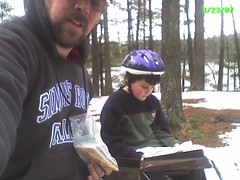During some random chattering online, I pointed a few folks at David Weber‘s works. I’ve really enjoyed the Honor Harrington series. Talk about pure unadulterated space opera. Big capital ships, multiple system alliances at war, fleet operations, and military politics all rolled together into a coherent and rich universe. Fantastic.
I have gotten in the habit of picking up each book as I go on my regular road trips. I usually finish one per visit, and there’s something like 14 books, so things are moving along nicely. I had also heard that Weber had published all the books onto CD, which sounded like a mighty inexpensive way of getting the material, but I didn’t relish having to haul my laptop around to read a story over a slice of pizza.
The other night I came across the Baen Free Library, a series of books that are available, for free, from the publisher. I highly recommend folks take a look at this page, where Eric Flint has an excellent commentary on copyright and why the current “brass knuckles” approach to enforcement is the wrong way to go.
At any rate, navigating around, I happily found the next book in the series I was looking for, and went “Hmm, I guess this should be put onto my Treo. I’ve been meaning to give this a shot…”
Off to Mobipocket to pick up an e-book reader. A quick sync later, and lo, I have the new book, and a reader, on my Treo.
How well does it work?
Surprisingly well. I admit I was a little leery of trying to read what has always been a paperback-sized book on a screen only 3″x3″ in size. Mobipocket does a good job of making it as painless as possible. I found myself settling into a comfortable reading pattern once I had made some small preference settings (go full screen, when scrolling to the next page don’t overlap lines – show the entire next page, etc etc). I think my one nudge is that a screen only holds about 1/4 of a page of text, so to read a single page, I have to ‘tap’ somewhere on the treo to tell it to go to the next page. Fine if I’m holding it in my hand, but when I’m eating lunch, it’s tedious to have to reach out and tap the screen or hit a button every 15 seconds or so. If there were a way to make it, oh, I don’t know, change pages when I tap my foot or something, that would be something. I guess I’ll have to wait on that toe-interface.
Commentaries on E-Books
So, it comes back to E-books. There’s been chatter for years about the idea that electronic book readers would replace paper books. Folks could just download the books they want into their reader, and they’d never need a paper version. Why hasn’t it really caught on? There is an electronic book market, but it’s tiny compared to the volume of paperbacks in the wild.
For me, it’s a combination of DRM and pure practicality. If I spend $6 on a paperback, I have it, I own it, it’s there. I can read it anytime I want, I can toss it on the shelf, come back to it in 10 years, and read it again. I can loan it to a friend, I can make notes in it, I can let my son read it. If I spill a drink on it, it gets wet. Then I dry it off, and read it again. If I run over it with the car, I can still read it, though it might be a bit mooshed.
If I spend $6 on an e-book, I have… a file. That file is most likely encrypted, and cannot be moved or copied around freely. I have to store it somewhere, perhaps on my Treo. I will not have this Treo in 10 years, so what do I do with the book? Store it on a CD? Okay now I have to make copies of it to a CD, and store that CD on a shelf. In 10 years, will anyone actually own CD readers that can read the filesystem on it? How about in 20 years? 30?
Or, if I download the book, put it on my Treo, and oops! I’ve mistakenly deleted it. Or the file got corrupted. Poof, it’s gone. The publishers will happily say “No problem! Just re-download the file” – assuming you can prove you own it, and the publisher is still in business, and you have the license key. Try that in 5 years. Or 15.
No, I don’t see E-books replacing paperbacks. The DRM issue is first and foremost a dead end roadblock, because there’s no working around these problems. The physical issues of ‘keeping track of media’ is something people can work on, and come up with their own solutions, but unless the media is free, there’s really no point in investing in a book collection where someone else holds the keys.



 A long time ago on a laptop far far away, I chanced across a new game called
A long time ago on a laptop far far away, I chanced across a new game called 



